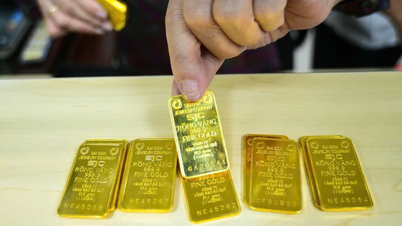Pressure is mounting on gold prices.
On the morning of July 28th, the global gold market opened with a downward trend. Spot gold prices in Asia at one point fell by nearly $10/oz, to $3,326/oz, after a significant drop from above $3,400/oz earlier last week to $3,336/oz by the end of the week.
In Vietnam, the price of SJC gold also followed this trend, falling by 600,000 VND/ounce to 121.1 million VND/ounce as of 10:00 AM on July 28th, according to the listed prices at major gold businesses.
The main reason gold is under pressure is increased risk appetite, stimulated by the trade agreements the US reached with Japan, the Philippines, and especially the European Union (EU) before the August 1 deadline.
According to Bloomberg , the US-EU framework agreement, which imposes a common 15% tariff on bilateral goods instead of the 25-30% that President Donald Trump had threatened, has eased months of trade tensions.
This positive news, coupled with the prospect of an extension of the US-China trade truce at the Stockholm talks on July 28, has fueled a strong flow of money into risky investment channels such as stocks and cryptocurrencies.
The US stock market saw impressive gains last week. On the final trading day of the week, July 25th, the broad S&P 500 index rose for the fifth consecutive session and also set new record highs. Meanwhile, the Nasdaq Composite technology index also continuously reached new highs during the week; the Dow Jones industrial index also rose and remained near record highs.

According to FactSet, 82% of the 169 companies in the S&P 500 that released second-quarter earnings exceeded expectations, providing momentum for the market. Experts at US Bank Wealth Management believe that the upward trend in US stocks will continue thanks to stable inflation, relatively stable interest rates, and growing corporate profits.
Meanwhile, the cryptocurrency market is also booming. Bitcoin remains at its all-time high, while Ethereum has seen a strong surge, attracting capital from investors. Gold, traditionally considered a safe-haven asset, has become less attractive as risk appetite prevails.
Furthermore, the likelihood that the US Federal Reserve (Fed) will keep interest rates unchanged at 4.25-4.5% at its meeting on July 29-30 (with a betting odds of up to 97.4%) is putting even more pressure on gold.
A stronger US dollar in the short term, with the Dollar Index fluctuating around 97.6 points, also contributed to curbing the rise of gold.
A sharp decline is possible if the price breaks below $3,300/oz.
Despite downward pressure, world gold prices showed signs of a slight recovery late on the morning of July 28, rising $4 to $3,342 per ounce.
However, analysts are still issuing warnings that gold may be entering a correction phase. Accordingly, the fact that gold prices have repeatedly failed to hold above the $3,400/oz mark recently indicates increasing technical risk. The fact that gold prices have broken through the important support level of $3,350 further increases the risk.
However, several factors could support gold prices in the medium and long term. Demand for gold in Asia, especially from retail investors and central banks, remains high. Whenever gold prices experience a sharp downward correction, demand typically surges, a familiar phenomenon in the market.
Furthermore, central banks around the world, particularly in developing countries, continue to buy gold to diversify reserves and reduce their dependence on the US dollar. This trend is reinforced by US President Donald Trump's pressure on the Federal Reserve (Fed) to lower interest rates.
Regarding monetary policy, the market is awaiting Federal Reserve Chairman Jerome Powell's speech after the July 30 meeting. Although interest rates are expected to remain unchanged this month, investors anticipate the Fed will cut rates at least twice in 2025, possibly starting at the September meeting. This is seen as a long-term support factor for gold, as low interest rates reduce the opportunity cost of holding gold – a non-interest-bearing asset.
Barbara Lambrecht from Commerzbank suggests that investment demand for gold may have peaked in the short term, but the long-term outlook remains positive due to geopolitical factors and monetary policy.
Key economic events this week will also influence gold prices. ADP employment data (Wednesday), the PCE price index (Thursday), and the non-farm payrolls report (Friday) will provide further clues about the health of the US economy, thereby impacting interest rate expectations and the US dollar.
Additionally, policy meetings at the Bank of Canada and the Bank of Japan could cause volatility in the USD, indirectly affecting gold.
In the short term, world gold prices may continue to face downward pressure, with the nearest support level at $3,300/oz (equivalent to VND 105.7 million/ounce). If US economic data continues to be positive and the Fed maintains a neutral stance after its meeting at the end of July, gold prices could fall further.
In Vietnam, the price of SJC gold – which is influenced by world prices and the USD exchange rate – could fall further by 1-2 million VND/ounce, to around 119-120 million VND/ounce.
However, in the medium and long term, gold remains a safe investment channel, supported by increasing demand from Asia, the trend of central banks buying gold reserves, and expectations of lower interest rates from 2026.


Source: https://vietnamnet.vn/gia-vang-chiu-ap-luc-don-dap-vang-mieng-sjc-co-lui-ve-119-trieu-dong-luong-2426443.html


![[Live] 2025 Community Action Awards Gala](/_next/image?url=https%3A%2F%2Fvphoto.vietnam.vn%2Fthumb%2F1200x675%2Fvietnam%2Fresource%2FIMAGE%2F2025%2F12%2F16%2F1765899631650_ndo_tr_z7334013144784-9f9fe10a6d63584c85aff40f2957c250-jpg.webp&w=3840&q=75)
![[Photo] Prime Minister Pham Minh Chinh receives Lao Minister of Education and Sports Thongsalith Mangnormek](/_next/image?url=https%3A%2F%2Fvphoto.vietnam.vn%2Fthumb%2F1200x675%2Fvietnam%2Fresource%2FIMAGE%2F2025%2F12%2F16%2F1765876834721_dsc-7519-jpg.webp&w=3840&q=75)
![[Image] The tenacious fighting spirit of Vietnamese women's football](/_next/image?url=https%3A%2F%2Fvphoto.vietnam.vn%2Fthumb%2F1200x675%2Fvietnam%2Fresource%2FIMAGE%2F2025%2F12%2F17%2F1765990260956_ndo_br_4224760955870434771-copy-jpg.webp&w=3840&q=75)

![[Image] Leaked images ahead of the 2025 Community Action Awards gala.](/_next/image?url=https%3A%2F%2Fvphoto.vietnam.vn%2Fthumb%2F1200x675%2Fvietnam%2Fresource%2FIMAGE%2F2025%2F12%2F16%2F1765882828720_ndo_br_thiet-ke-chua-co-ten-45-png.webp&w=3840&q=75)
![[Photo] Prime Minister Pham Minh Chinh receives the Governor of Tochigi Province (Japan)](/_next/image?url=https%3A%2F%2Fvphoto.vietnam.vn%2Fthumb%2F1200x675%2Fvietnam%2Fresource%2FIMAGE%2F2025%2F12%2F16%2F1765892133176_dsc-8082-6425-jpg.webp&w=3840&q=75)









































































![[Live] Closing Ceremony and Award Presentation for the "Impressive Vietnam Tourism" Video/Clip Creation Contest 2025](https://vphoto.vietnam.vn/thumb/402x226/vietnam/resource/IMAGE/2025/12/17/1765974650260_z7273498850699-00d2fd6b0972cb39494cfa2559bf85ac-1765959338756946072104-627-0-1338-1138-crop-1765959347256801551121.jpeg)
























Comment (0)